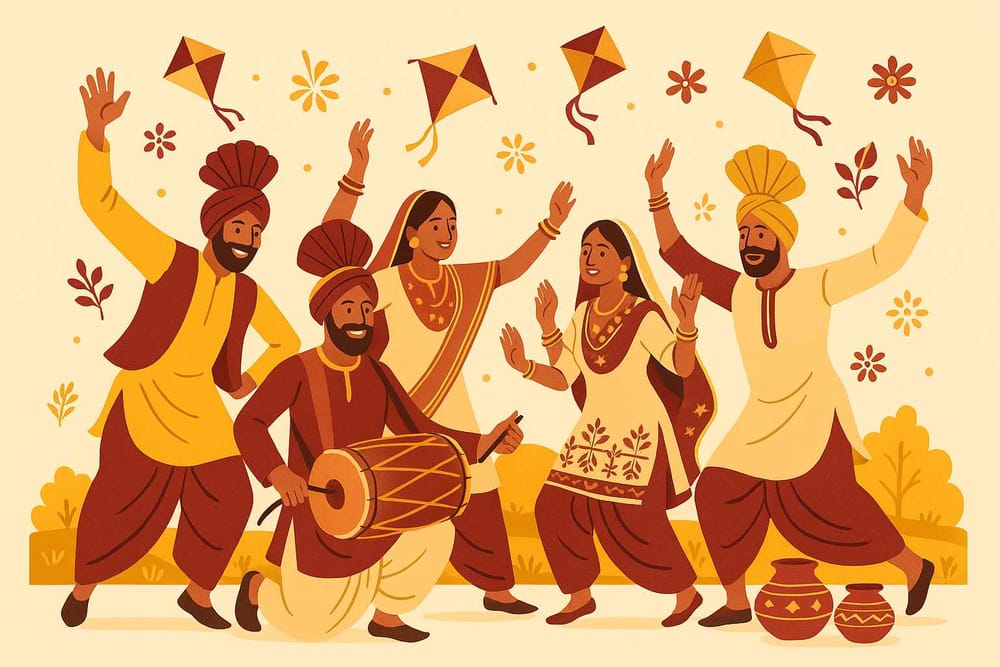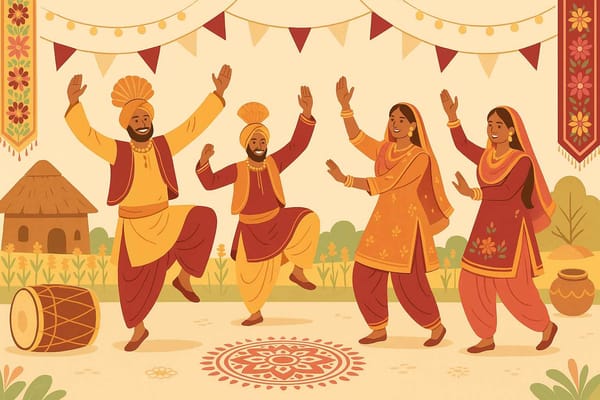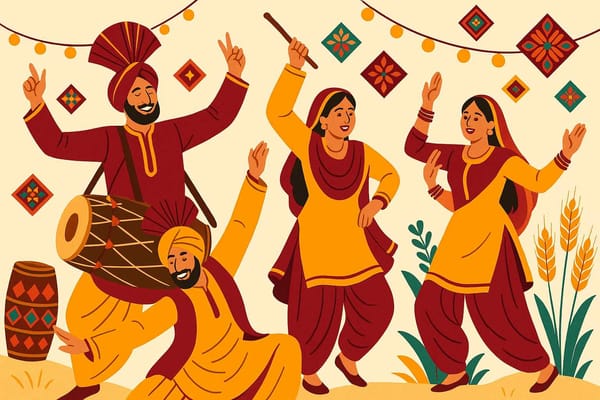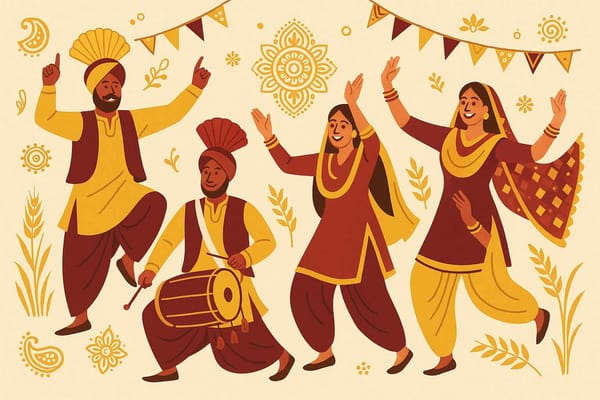
Folk Dances of Punjab-Explore Vibrant Traditions
Close your eyes for a moment. Can you hear it? The powerful, infectious beat of a dhol that seems to echo right from the soul of the earth. Can you see the flash of vibrant colours – the brilliant yellows of mustard fields and the deep indigos of a rural evening sky? This is the essence of Punjab, a land whose spirit is best expressed not just in words, but in the joyous, energetic rhythms of its folk dances.
These dances are more than just movements; they are the dhadkan (heartbeat) of a community, a living history passed down through generations. They tell stories of hard work, of celebrating a bountiful harvest, and of the simple, profound joy of being together. Let’s take a walk through the vibrant fields and villages of Punjab to feel the energy of these beautiful art forms.
From the Fields to the Festivities: The Roots of Punjabi Dance
The story of Punjab's folk traditions begins in its fertile fields. Imagine farmers, after months of toil, seeing their crops sway in the breeze, ready for harvest. What better way to express their gratitude and happiness than through dance? This is how dances like Bhangra were born, as a spontaneous celebration during festivals like Vaisakhi.
These weren't performances for an audience; they were a way for the entire village to come together, to share in the collective happiness. The movements themselves often mirrored the actions of farming – sowing seeds, cutting wheat, and celebrating the fruit of their labour. Over centuries, with influences from different eras, these raw expressions of joy evolved, but they never lost their connection to the land and its people. They are a beautiful reminder that our most profound traditions are often rooted in the simple rhythms of life.
The Heartbeat of Celebration: Punjab's Most Cherished Dances
While Bhangra and Giddha are the most famous faces of Punjabi dance, the region's cultural treasure chest is filled with many other gems. Each dance has its own unique flavour and story.
Bhangra: The Roar of Unbridled Joy
When you think of Punjabi dance, Bhangra is probably the first thing that comes to mind. It is pure energy, a powerful expression of celebration. Originally a harvest dance performed by men, it has now beautifully evolved into a global phenomenon that welcomes everyone to join in. The dance is driven by the mighty dhol, with the tumbi and chimta adding their own unique melodies to the electrifying atmosphere.
The dancers, dressed in colourful kurtas, billowing chadras, and proud turbans (pagris), move with an energy that is simply contagious. Bhangra is a testament to the resilient and high-spirited nature of the Punjabi people, a dance that can turn any gathering into a grand celebration.
Giddha: The Graceful Language of Women
If Bhangra is the thunderous roar, Giddha is the elegant and witty poetry. Performed by women, Giddha is a circle of grace, rhythm, and storytelling. It’s less about high-octane energy and more about fluid movements, synchronized clapping, and the singing of ‘boliyan’ – short, humorous, and often satirical couplets that speak of everything from family life to social commentary.
Dressed in traditional salwar kameez and adorned with intricate phulkari dupattas that tell their own stories, the women create a mesmerising spectacle. Giddha is a beautiful display of female camaraderie and creativity, a space where stories are shared and bonds are strengthened through laughter and dance.
Exploring Deeper Rhythms: Other Vibrant Folk Forms
The world of Punjabi folk dance is rich and diverse. Beyond the famous duo of Bhangra and Giddha, several other forms capture the region's spirit:
- Jhumar: This dance, with its roots in the Sandalbar region, is a graceful and rhythmic dance of joy. Dancers move in a circle, creating a slow, beautiful trance-like effect that is absolutely captivating to watch. It's often performed at weddings and festivals, bringing a sense of calm and collective happiness.
- Sammi: A dance performed by women, Sammi tells tales of love and longing. It's a gentle, flowing dance characterized by intricate footwork and expressive hand gestures. It carries a certain nostalgic charm, often sung in memory of a beloved, making it a deeply emotional and beautiful performance.
- Malwai Giddha: Don't be confused by the name! This is a unique and powerful form performed by men, mostly from the Malwa region. It's a mix of dance and folk poetry, often involving theatrical mimicry and performed with traditional instruments like the Chimta and Dholaki. It’s a riot of fun and folk wisdom.
- Luddi: This is a dance of victory and celebration, performed primarily by men. It involves energetic, athletic movements, including high jumps and spins, often performed with one hand on the back and the other waving in the air. Luddi is a pure expression of triumph and happiness.
Keeping Our Heritage Alive in a Modern World
These folk dances are more than just entertainment; they are a vital link to our roots, a way of keeping our stories and values alive. They teach us about community, the joy of celebration, and the importance of our connection to our culture. Each step and every beat carries the wisdom of our ancestors.
At Bhaktilipi, we believe in the power of these traditions. Just as these dances preserve the soul of Punjab, we are dedicated to preserving and sharing the timeless devotional stories and literature of India for today's generation. Understanding these cultural expressions helps us connect more deeply with our spiritual heritage. This deep connection between art and culture is a beautiful tapestry, much like the rhythm of heritage found in folk traditions across our country.
If the vibrancy of Punjabi culture inspires you, you might also enjoy exploring the rich traditions of other regions, like the stories behind celebratory wear in Rajasthan, which also tells a tale of heritage and pride.
A Celebration for Everyone
The true beauty of Punjabi folk dances is their open-heartedness. They invite everyone to join in, regardless of age or skill. You don't need to be a professional to feel the joy of Bhangra or the grace of Giddha. These dances live in the hearts of the people and are performed with gusto at weddings, festivals, and family gatherings, bringing everyone together in a shared moment of happiness.
So, the next time you hear the beat of a dhol, don't just stand by and watch. Let the rhythm move you. Let yourself be a part of a tradition that celebrates life in its most vibrant and joyful form. After all, these dances are a powerful reminder that our culture is not just something to be read about, but something to be lived, felt, and celebrated with all our hearts.
A passionate group of people dedicated to preserving India's knowledge of Dharma, Karma, and Bhakti for ourselves and the world 🙏.
Comments
Related in

Folk Dances of Punjab - Celebrate Rich Culture
The moment you hear the deep, resonant beat of a dhol, something inside you stirs. It’s a call to joy, a rhythm that travels from your ears to your feet, making you want to move. This is the magic of Punjab, a land where every celebration, every season, and

Vibrant Folk Dances of Punjab: A 2025 Cultural Journey
The very soul of Punjab beats to the rhythm of the dhol. It’s a sound that echoes through its lush green fields, a sound that calls people to gather, to celebrate, to feel alive. This isn't just music; it's the living, breathing essence of Punjabi

Folk Dances of Punjab: Weave the Cultural Tapestry
Have you ever felt a beat so powerful it seems to echo right in your soul? That’s the magic of Punjab for you. It’s a land where the earth itself seems to dance, where the joy of a good harvest, the celebration of a wedding, or simply the
